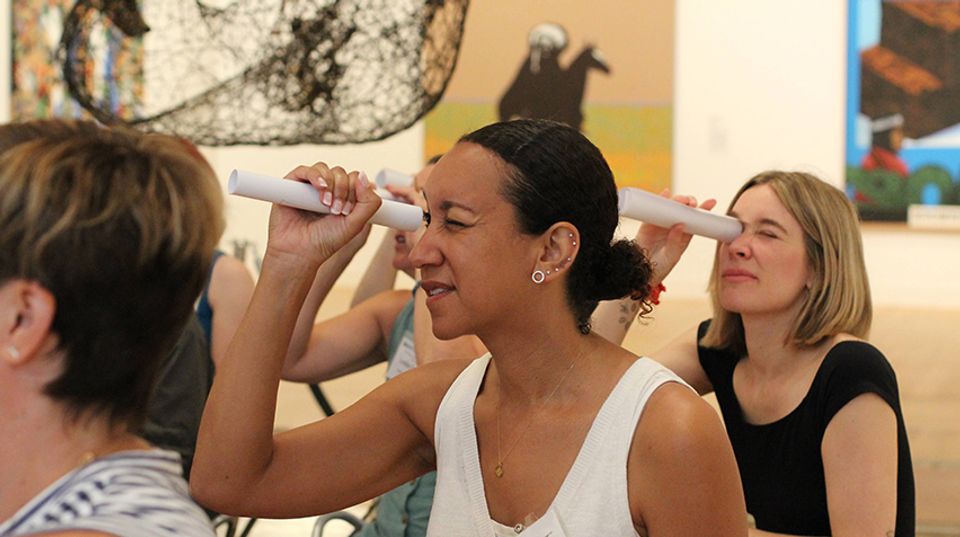
Washington National Opera, Domingo Cafritz Young Artist Program, Photo by Harold Dorwin
Washington National Opera Principal Coach for the Domingo-Cafritz Young Artists Ken Weiss provides some insider information on how he selected the artists and repertoire for the upcoming January 22 performance in the Renwick Gallery's Grand Salon, in a discussion with Jo Ann Gillula, Chief of External Affairs at the museum.
Eye Level: Traditionally, the Domingo-Cafritz Young Artists program has presented operatic scenes at the Renwick. This performance opens with art songs by Richard Strauss. Can you tell us why you selected these and what you particularly love about them?
Ken Weiss: I think of each of these songs as a miniature operatic scene, developing a distinct character and telling a story. They're especially challenging because you have to engage the audience in the character and story quickly, and without the aid of sets, props or costumes. All the drama has to be created with the music and the poetry alone, and that makes song repertoire great training for opera singers!
If you know Richard Strauss primarily from his operas, the shocking Expressionism of Salome and Elektra, or the grand depictions of Viennese high society in Arabella and Der Rosenkavalier—these songs may be a surprise to you, as they're very intimate and lyrical pieces. We've chosen five that each depict a different stage of love, and arranged them as though they were five scenes from one growing and changing relationship.
EL: You are also presenting Lieder by Gustav Mahler. What led you to present this German repertoire?
KW: The Lieder eines fahrenden Gesellen, or "Songs of a Wayfarer," are among Mahler's most personal and heartfelt pieces. They tell the story of a young man who leaves his home, looking for solace on the open road, when the girl he loves marries someone else. Mahler wrote the texts himself, in the aftermath of a failed love affair in his own life, and they're a beautiful and heartbreaking chronicle of the stages of his grief.
Both the Mahler and the Strauss offer pianist Artem Grishaev a special opportunity to shine. Those of us who work in opera houses spend most of our time playing piano arrangements of scores really written for orchestra. In this program, Artem gets to play music originally composed for the piano (though Mahler later orchestrated this set, and it's often heard in the orchestral version.)
EL: You conclude these musical offerings with some of the best-loved operetta composers: Lehar, Siecynski, and Kalman. Why such a contrast and what about these selections appealed to you?
KW: The German and Austrian Romantics wrote a lot of emotionally intense music, but no portrait of their time would be complete without its lighter side! The sparkling music of operetta was an essential part of the musical scene in the time of Strauss and Mahler, and they had more in common with operetta composers than you might suspect. They drew on the same influences, and shared a musical language. The first song in the Mahler group, for example, features what sounds like gypsy (or klezmer) wedding music—the same kind of music explored in Emmerich Kalman's Komm, Zigany, which leads off our operetta set. The Viennese waltz, so prominent in Franz Lehar's operettas, also turns up constantly in the works of Richard Strauss, most famously in Der Rosenkavalier.
EL: What can we look forward to in hearing these young artists?
KW: All three singers on this program are accomplished young professionals beginning to appear in major companies around the U.S. and abroad. Jennifer Waters and Javier Arrey made acclaimed debuts in last summer's Menotti festival at the Palau de les Arts in Valencia, Spain; Jeffrey Gwaltney stepped in last summer on short notice to take over the principal role of Giasone in Glimmerglass Opera's production of Cherubini's Medea. Pianist Artem Grishaev comes to us from the training program at Moscow's Bolshoi Opera, after recent performances at the Queen Elizabeth Competition.
We built this program around music that the artists really wanted to perform. They bring not only technical and musical skill, but also a personal commitment to this material, and it's been really exciting to work on it with them.
EL: What do you enjoy about performing opera in the Grand Salon?
KW: The Grand Salon has wonderful, resonant acoustics, and a terrific piano. It's particularly appropriate for this program, because it dates from the same era as the music we're performing. But it's proved to be a wonderful venue for all sorts of repertoire, from Mozart and Verdi, to Russian opera and zarzuela. Our most longstanding tradition in the Grand Salon is our annual performance of scenes from American opera, and we're looking forward to this year's performance on May 20th!

















